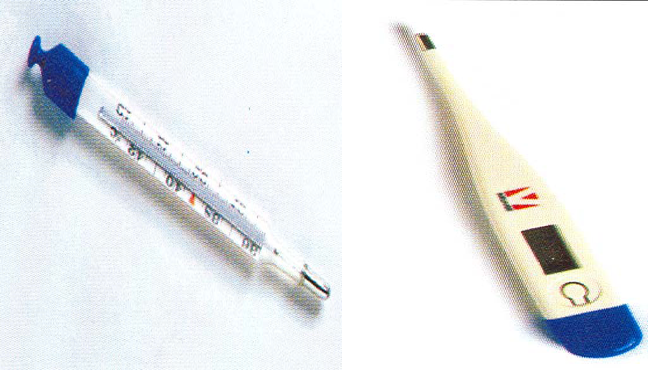To perform elementary procedures on animals there are a few very important aspects that must be kept in mind. At first, we will discuss a few of the procedures before we attempt to perform them. Make sure you understand how the apparatus works before you use it. Especially instruments like a Burdizzo can cause the animal a lot of discomforts and damage the animal permanently if applied incorrectly.
Thermometer
To take the body temperature of an animal you only need a good clinical thermometer. The temperature is normally taken in the anus of the animal. Normally the animal will feel no discomfort and will not react too much. Large untamed animals can be difficult and need a little bit of restraint just to insert the thermometer and take it out again.

Veterinary Supplies
Over time and as your experience increases, you will accumulate more vet supplies than I’ve listed here, but this is a good starting kit.
Antiseptic and Sanitizing Fluids
The ones we find regular use for are alcohol, iodine, and peroxide. The alcohol is good for sanitizing thermometers and other supplies, and for cleansing skin prior to giving an injection. Iodine (7%) is a good general wound cleanser and works well for cleaning navels on newborns. Peroxide is the best thing to use for cleaning wounds in which maggots reside.
Aspirin Boluses
(or the extra-large economy-size bottle of generic people aspirin), for relief of aches, pains, lameness and fever. If you use people aspirin, one tablet per hundred pounds of body weight works well (1 tablet per 45 kg).
Clean Blankets, Towels and Cloth “Rags”
Old towels and blankets come in handy when drying off animals (like newborns) and when warming animals that are in shock. The rags have many uses, including cleaning wounds, cleaning caked manure from young animals’ tail-heads, and other clean-up chores. The ideal rag is cut from old bath towels – 12-square-inches (30 cm2) seems to be a good size. Thrift stores and yard sales are good sources for used blankets and towels.
Needles and Syringes
Keep several disposable needles (size 18 gauge – 1.5” is the most versatile) and several syringes 6cc, 20cc and 60cc) on hand at all times. Syringes come in handing for feeding very weak animals (like newborns). To feed with a syringe, slowly dribble milk, electrolyte, or colostrum into the mouth.
Cow Magnet
If you plan to keep livestock, keep several cow magnets on hand. Cow magnets are about the size of an adult’s pinky, rounded on both ends, and have no sharp edges.
Stomach Tubes
About 6 feet (183 cm) of soft rubber tubing works well. If you are using a tube to force-feed fluids, make sure that you insert it in the animal’s stomach and not its lungs, or you’ll drown the animal. To confirm that the tube is in the stomach, blow into the end of it – if you are on target, you’ll see the animal’s side expand.
Thermometer
Absolutely the most important item in a vet box! Purchase a rectal veterinary thermometer with a ring top and tie about 2 feet (60 cm) of string to it. While taking an animal’s temperature, either hold the end of the string or wrap it several times around the critter’s tail. This prevents “losing” the thermometer inside the animal, or having the thermometer fall out, only to be crushed by a hoof.